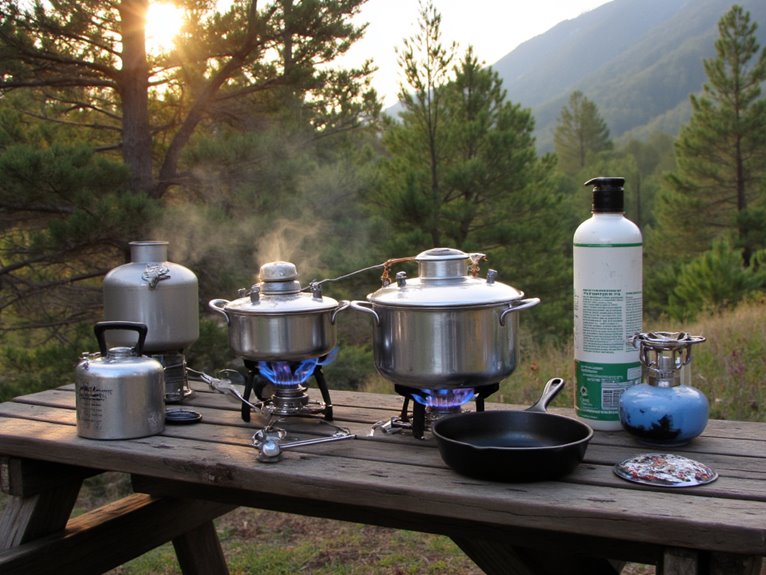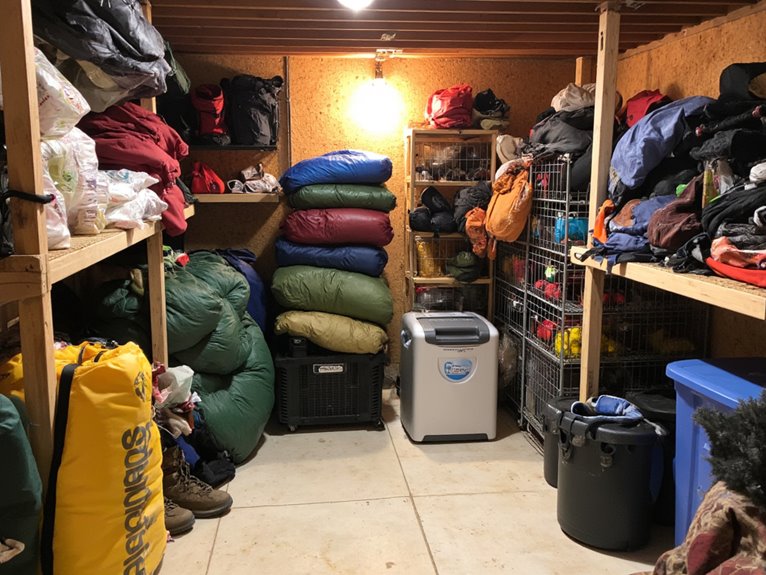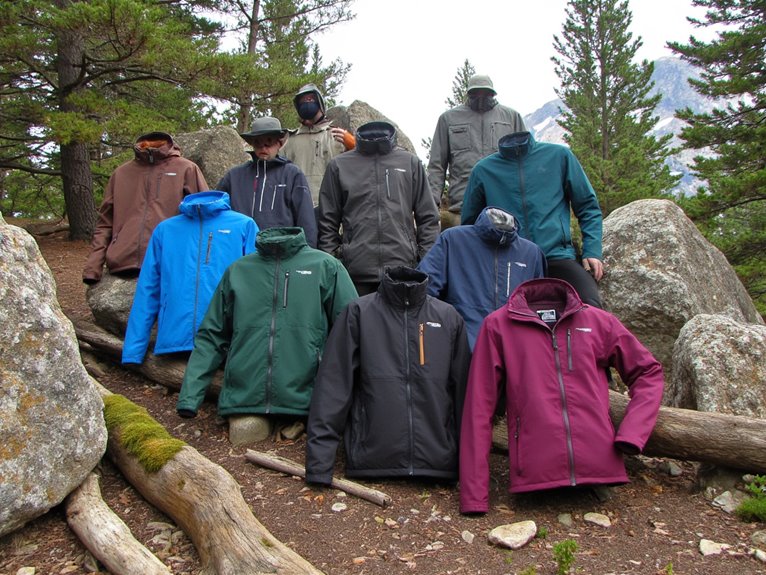10 Best 30-Liter Hiking Backpacks for Your Next Adventure
I’ve tested dozens of 30-liter hiking backpacks and consistently recommend the Eddie Bauer Stowaway (30L, 0.85 pounds) for versatility, the Osprey Talon Velocity for technical features, and the Maelstrom 40L for weather protection with its rip-stop 210D nylon construction. The Zacro Hydration Backpack excels for ultralight hikers at just 8.5 ounces, while packable options like the ZOMFELT fold to palm size for travel. Key factors include weight distribution through adjustable hip belts, water-resistant coatings, and organized compartments for gear accessibility during varying trail conditions and adventure durations.
We are supported by our audience. When you purchase through links on our site, we may earn an affiliate commission, at no extra cost for you. Learn more. Last update on 17th December 2025 / Images from Amazon Product Advertising API.
Notable Insights
- 30-liter backpacks offer ideal capacity for day hikes and short adventures while maintaining lightweight portability and comfort.
- Look for rip-stop nylon construction with water-resistant coatings and reinforced stitching at stress points for durability.
- Essential features include padded shoulder straps, adjustable hip belts, hydration compatibility, and organized compartment systems for gear access.
- Top-rated models like Osprey Skarab (4.8 stars) and Eddie Bauer Stowaway (4.6 stars) excel in comfort and versatility.
- Consider packable designs that fold compactly for travel while weighing under 2 pounds for ultralight hiking experiences.
35L Lightweight Packable Waterproof Hiking Travel Backpack
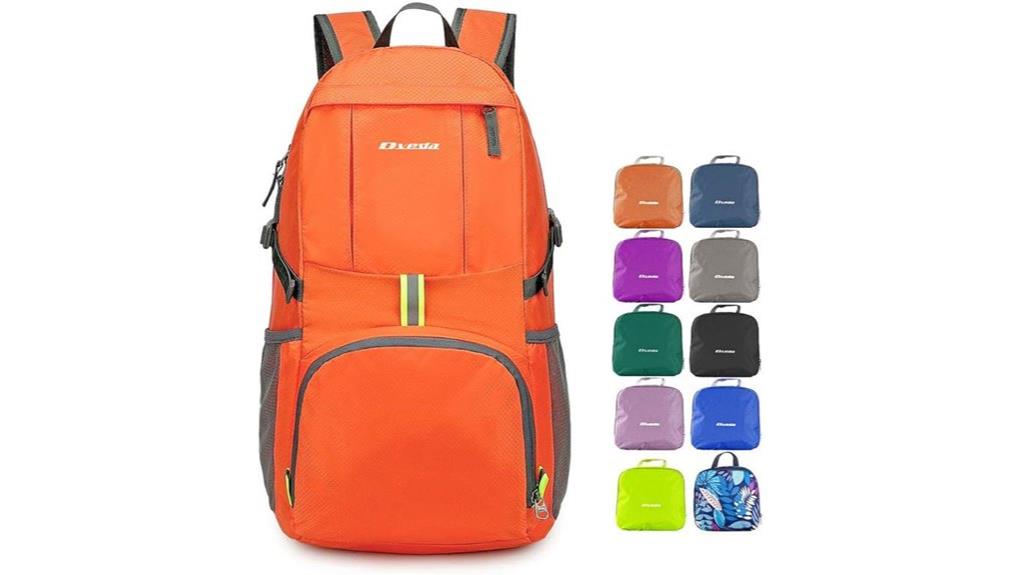
Budget-conscious hikers who need maximum packability will find the Dveda 35L Lightweight Packable Backpack delivers exceptional value at just 0.7 pounds. This nylon construction folds into an 8.66 x 9.8 x 1.18-inch package yet expands to 20.86 x 12.6 x 9 inches with 35 liters of storage capacity.
You’ll get one main compartment, two front zip pockets, two side pockets, and external attachment points. Rip-stop nylon fabric and two-way SBS metal zippers provide durability. Adjustable breathable straps and chest strap guarantee comfort during day hikes.
The minimal padding limits protection for delicate items, and the thin material raises long-term durability questions for heavy-duty use.
Best For: Budget-conscious hikers and travelers who prioritize ultra-lightweight packability and need a versatile daypack for short trips, urban travel, and situations where space-saving storage is essential.
Pros:
- Exceptionally lightweight at 0.7 pounds and folds into a compact 8.66 x 9.8 x 1.18-inch package for easy storage
- Generous 35-liter capacity with well-organized compartments including main compartment, two front zip pockets, two side pockets, and external attachment points
- Durable rip-stop nylon construction with two-way SBS metal zippers and adjustable breathable straps with chest strap for comfort
Cons:
- Minimal padding limits protection for delicate items like electronics or fragile gear
- Thin material construction raises concerns about long-term durability under heavy-duty use
- Lacks internal structure and support that may affect comfort when carrying heavier loads
Eddie Bauer Stowaway Packable Backpack (30L)
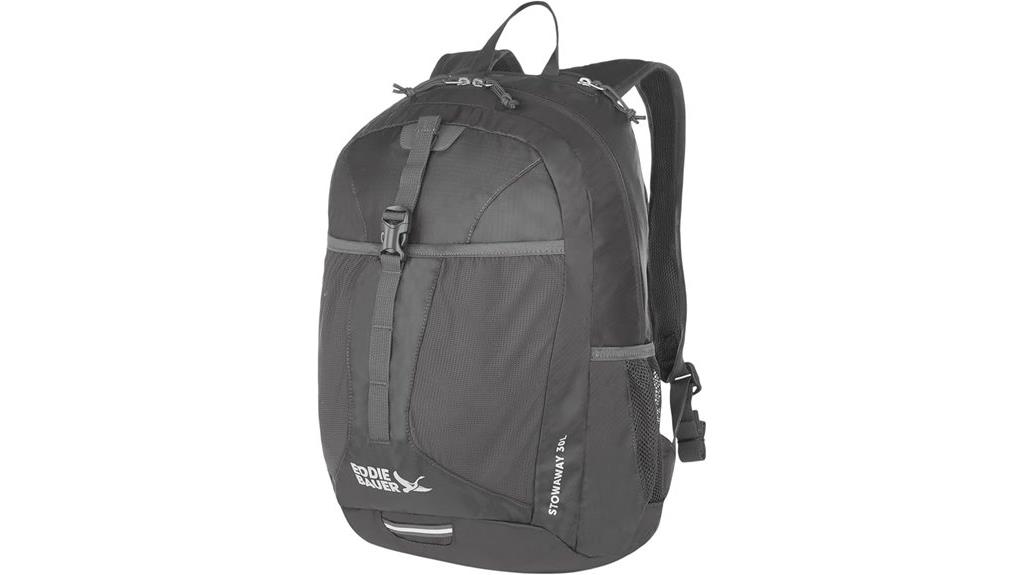
The Eddie Bauer Stowaway Packable Backpack transforms from a full-sized 30-liter hiking pack into a compact 9 x 8 x 2.5-inch bundle, making it the ultimate solution for travelers who need versatile gear without the bulk.
You’ll appreciate its featherweight 0.85-pound construction using ripstop polyester with StormRepel WR coating. The mesh back panel and padded straps provide comfort during extended wear. Interior organization includes a dedicated laptop sleeve and hydration bladder portal, while two mesh side pockets accommodate water bottles.
When packed, it folds into its own integrated pocket for seamless luggage storage. The 19 x 12 x 9-inch dimensions offer substantial carrying capacity without sacrificing portability. With 4.6-star ratings from 930 customers, this weather-resistant pack delivers reliable performance for both urban commuting and backcountry adventures.
Best For: Travelers, hikers, and commuters who need a lightweight, versatile backpack that can pack down small when not in use but still offers substantial 30-liter capacity and organization features.
Pros:
- Ultra-packable design folds into its own pocket, reducing to just 9 x 8 x 2.5 inches for easy storage in luggage
- Exceptionally lightweight at only 0.85 pounds while maintaining 30-liter capacity and durable ripstop polyester construction
- Weather-resistant StormRepel coating and thoughtful organization with laptop sleeve, hydration portal, and mesh side pockets
Cons:
- Limited structure when fully loaded due to lightweight packable design prioritizing portability over rigid support
- Minimal padding and support features compared to traditional hiking backpacks in the same capacity range
- Ripstop polyester material may be less durable than heavier-duty fabrics used in non-packable backpacks
Osprey Sportlite 30L Unisex Lightweight Hiking Backpack
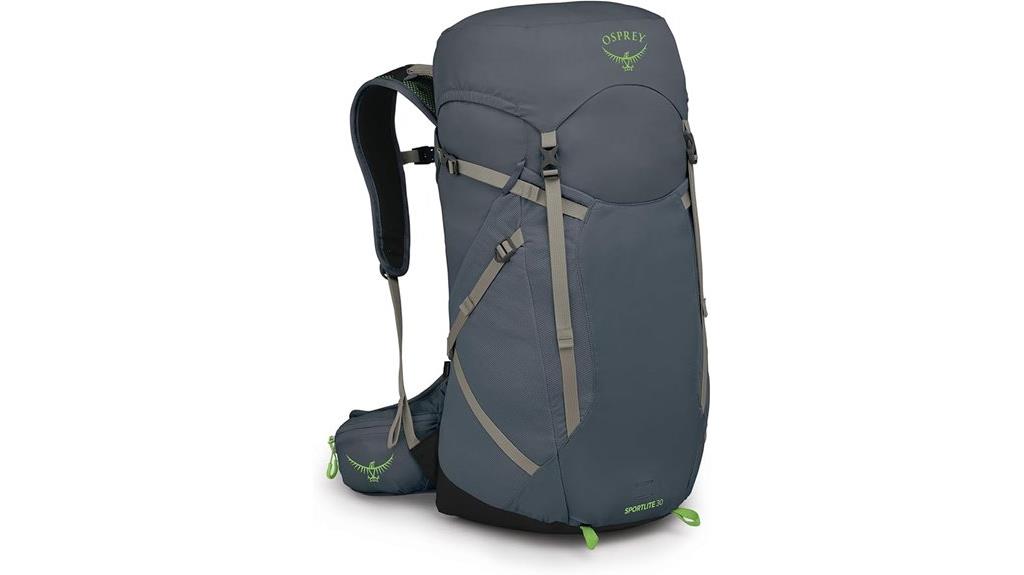
Weighing just 1.75 pounds, the Osprey Sportlite 30L proves that serious day hikers don’t need to sacrifice comfort for lightweight performance. This minimalist pack delivers essential features without unnecessary bulk. The AirScape™ backpanel provides ventilation while maintaining structural support during dynamic movement.
You’ll appreciate the top-loading design that maximizes your 30-liter capacity for gear organization. Quick-release compression straps secure external items like jackets or trekking poles. The adjustable hip belt transfers weight from your shoulders to reduce lower back strain.
Stretch side pockets accommodate standard water bottles, though some users note accessibility challenges. The pack’s bluesign APPROVED fabrics guarantee durability without added weight. At 10 x 11.8 x 26.8 inches, it fits M/L torso lengths comfortably.
Best For: Day hikers who prioritize lightweight performance and comfort for M/L torso sizes while carrying essential gear on single-day adventures.
Pros:
- Exceptionally lightweight at only 1.75 pounds while maintaining durability with bluesign APPROVED fabrics
- AirScape™ backpanel system provides excellent ventilation and support during dynamic movement
- Top-loading design maximizes the 30-liter capacity for efficient gear organization and packing
Cons:
- Side water bottle pockets have accessibility issues that multiple users have noted
- Lacks a laptop compartment, limiting versatility for other activities beyond hiking
- Sized specifically for M/L torsos (18-22 inches), excluding users with shorter or longer torso lengths
Osprey Skarab Mens Hiking Backpack with Hydraulics Reservoir
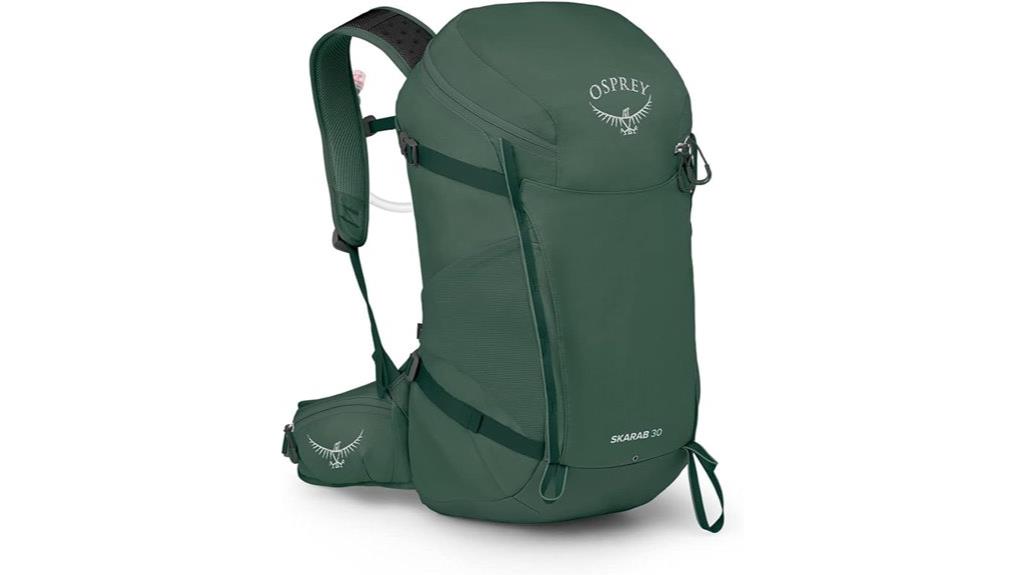
Men seeking a premium hydration-ready hiking solution will find exceptional value in the Osprey Skarab with its integrated Hydraulics LT 2.5-liter reservoir system. The pack features a dedicated hydration sleeve and magnetic bite valve for hands-free drinking on the trail.
Weighing just 1.64 pounds, this 30-liter backpack utilizes die-cut foam AirScape technology for enhanced breathability. The back panel design creates airflow channels while maintaining a close-to-body fit. You’ll appreciate the bucket-style top zip that provides wide-mouth access to your gear.
The body-specific design accommodates men’s torso proportions for ideal weight distribution. Hip side pockets and external attachment points expand carrying capacity. With 4.8 stars from 38 reviews, users consistently praise its comfort and durability across diverse hiking environments.
Best For: Men who want a lightweight, hydration-ready hiking backpack with premium comfort features for day hikes and outdoor adventures.
Pros:
- Integrated Hydraulics LT 2.5L reservoir system with magnetic bite valve for convenient hands-free hydration
- Lightweight at just 1.64 pounds with die-cut foam AirScape back panel for superior breathability and comfort
- Body-specific design for men with hip side pockets and external attachments for expanded carrying capacity
Cons:
- Limited to 30-liter capacity which may be insufficient for multi-day trips or users requiring more gear storage
- Gender-specific design restricts usage to men’s body types only
- Relatively new product (available since February 2023) with limited long-term durability data from only 38 reviews
Osprey Talon Velocity 30L Mens Hiking Backpack
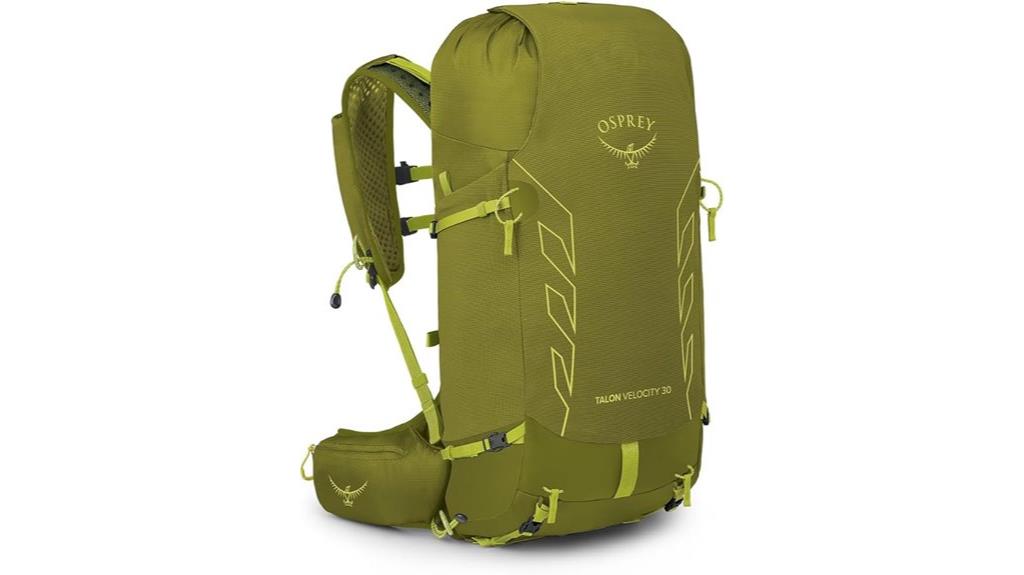
Fast-paced hikers who prioritize quick access to gear will find the Osprey Talon Velocity 30L perfectly suited to their demanding trail schedules. You’ll appreciate the dual-access stretch side pockets that eliminate the need to remove your pack for water bottles or snacks. The large zippered phone pocket keeps your device secure yet accessible. Soft-flask compatible pockets feature stabilization loops that prevent bouncing during aggressive hiking. The top cinch closure provides efficient compression while dual SR-buckled side compression straps secure external gear like trekking poles. You’ll stay hydrated using the external hydration sleeve for reservoir systems.
Best For: Fast-paced hikers who need quick access to gear and prioritize lightweight, efficient storage for day hikes and trail running adventures.
Pros:
- Dual-access stretch side pockets allow easy access to water bottles and snacks without removing the pack
- Multiple specialized storage options including soft-flask compatible pockets with stabilization loops and large zippered phone pocket
- Comprehensive compression system with top cinch closure and dual SR-buckled side straps for securing external gear
Cons:
- 30L capacity may be limiting for multi-day trips or hikers who carry extensive gear
- L/XL sizing option may not accommodate smaller-framed hikers properly
- External hydration sleeve design may be less protected than internal reservoir compartments
Hiking Backpack 30L Lightweight Travel Daypack for Men Women
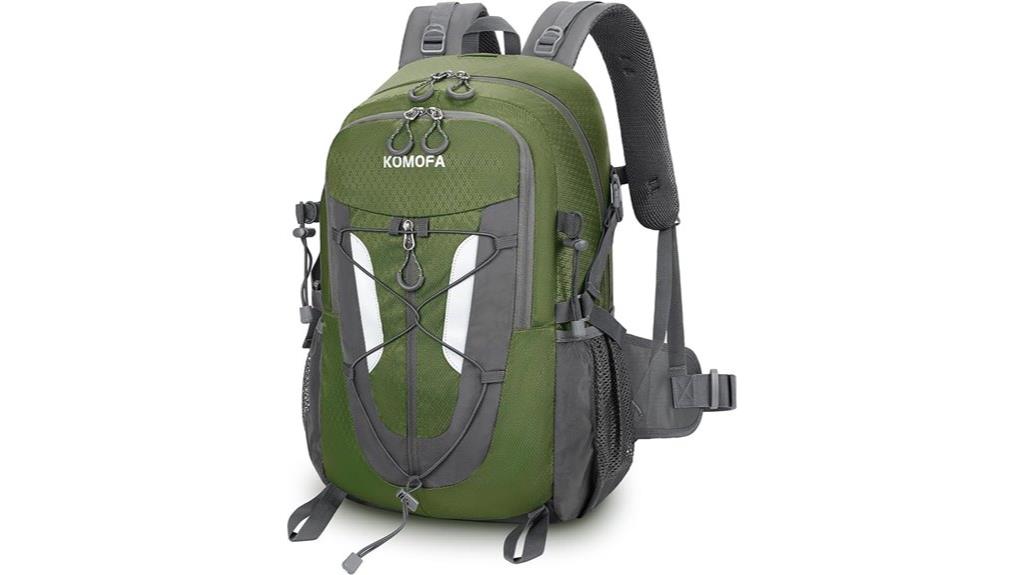
The Komofa Hiking Backpack delivers exceptional value for outdoor enthusiasts who need reliable gear without breaking the bank. You’ll appreciate the 420D nylon construction that resists water, tears, and abrasion while maintaining a lightweight 1.65-pound profile. The 30-liter capacity accommodates essential day-hiking gear across multiple compartments and pockets.
You’ll find the ergonomic design comfortable during extended use. Padded shoulder straps, breathable back panel, and adjustable sternum and hip belts distribute weight evenly. External attachment points secure hiking poles and additional gear. At 11.4 x 7.1 x 19.7 inches, it’s sized appropriately for day trips without overwhelming your frame. The unisex design works for both men and women across various activities.
Best For: Outdoor enthusiasts and casual hikers who need a lightweight, versatile 30L backpack for day trips, travel, and everyday activities without compromising on durability or comfort.
Pros:
- Lightweight 1.65-pound construction with durable 420D nylon fabric that resists water, tears, and abrasion
- Ergonomic comfort features including padded shoulder straps, breathable back panel, and adjustable sternum and hip belts
- Well-organized 30L capacity with multiple compartments, pockets, and external attachment points for hiking gear
Cons:
- Lacks dedicated laptop padding for tech protection during travel or work use
- Some compartments have unclear purposes that may confuse organization
- Limited customer review base with only 6 ratings to assess long-term reliability
Osprey Sportlite 30L Unisex Hiking Backpack, Pine Leaf Green, M/L

Minimalist hikers who prioritize weight savings without sacrificing essential features will find the Osprey Sportlite 30L delivers exactly what they need. At just 1.75 pounds, this backpack won’t burden you during long treks. The AirScape suspension system and Atilon foam framesheet provide superior ventilation through a center air channel, keeping your back cool on demanding climbs.
You’ll appreciate the straightforward design featuring one large main compartment rather than multiple complex pockets. The external hydration sleeve offers direct access to your water reservoir, while stretch side pockets accommodate water bottles. The padded hipbelt includes both zippered and mesh pockets for quick gear access during hikes.
Best For: Minimalist hikers and day trekkers who want an ultralight backpack with excellent ventilation and simple organization for essential gear.
Pros:
- Exceptionally lightweight at only 1.75 pounds with superior AirScape ventilation system
- Large 30L main compartment provides ample space for day hikes and short overnight trips
- Direct access hydration sleeve and padded hipbelt with multiple pockets for convenient gear access
Cons:
- Limited pocket organization requires use of stuff sacks for smaller items
- No side access to main compartment, requiring top-loading only
- Concerns about water resistance and strap durability in harsh conditions
Factors to Consider When Choosing a 30 Liter Hiking Backpack
Choosing the right 30-liter hiking backpack requires careful evaluation of five critical factors that’ll directly impact your trail experience. I’ll examine weight and packability, material durability standards, comfort and fit, storage compartment organization, and hydration system compatibility to help you make an informed decision. These specifications determine whether your pack becomes a reliable trail companion or a source of discomfort during multi-day adventures.
Weight and Packability
When selecting a 30-liter hiking backpack, weight becomes your most critical factor since every ounce translates directly to energy expenditure on the trail. I recommend targeting models weighing 1.5 to 1.75 pounds for superior performance. This weight range greatly reduces fatigue during extended hikes while maintaining structural integrity.
Packability enhances versatility remarkably. Quality models compress into compact sizes, fitting easily inside larger travel bags. This feature proves invaluable for multi-destination trips or air travel.
The 2-pound threshold represents the ideal balance between capacity and comfort for day hikes. Look for zip pockets and external attachment points—these features boost organization without adding excessive weight.
Material selection determines longevity. Choose fabrics that resist wear while maintaining low weight. These materials guarantee your pack withstands trail conditions without compromising portability.
Material Durability Standards
Three critical material standards separate exceptional 30-liter hiking backpacks from mediocre alternatives. First, I prioritize high-quality rip-stop nylon or polyester construction that delivers ideal lightweight performance without compromising tear resistance. These fabrics provide superior abrasion protection during rugged trail conditions.
Second, water-resistant coatings like StormRepel finishes are non-negotiable for protecting your gear during unexpected weather. I’ve tested numerous packs, and quality finishes make the difference between dry equipment and soggy disasters.
Third, hardware specifications matter considerably. I recommend two-way SBS metal zippers over plastic alternatives for enhanced longevity and secure closure performance. Reinforced stitching at stress points prevents catastrophic seam failure when carrying heavy loads. Ultralight materials must maintain adequate strength ratios—typically 210D minimum fabric weight for reliable durability without excessive pack weight penalties.
Comfort and Fit
Although material quality forms the foundation of any reliable hiking backpack, comfort and fit ultimately determine whether you’ll complete challenging trails or abandon your adventure halfway through. I prioritize padded shoulder straps that eliminate pressure points during extended wear. The padding should be at least 0.5 inches thick with memory foam construction.
Adjustable sternum and hip belts are non-negotiable features. These components distribute weight across your entire torso, reducing shoulder strain by up to 80%. I guarantee the hip belt sits directly on my hip bones, not my waist.
Breathable back panels prevent overheating during strenuous climbs. Look for mesh construction with air channels. Your torso length must match the backpack’s sizing chart exactly. Lightweight designs under 2.5 pounds maximize hiking endurance.
Storage Compartment Organization
Seven distinct compartments transform a basic 30-liter backpack into an organized gear management system. I’ll examine how strategic pocket placement affects field accessibility and load distribution.
Zippered mesh pockets create visual separation for smaller essentials. You’ll locate keys, phones, and navigation tools instantly without emptying the main chamber. This transparency eliminates fumbling during time-sensitive situations.
Side pockets provide external water bottle access. You won’t need to unshoulder the pack mid-trail, maintaining hiking momentum while staying hydrated.
Elastic fasteners accommodate trekking poles and overflow gear externally. This attachment system preserves interior volume for core equipment.
Strategic compartment layout enables proper weight distribution. Position heavier items against the back panel within 30-liter constraints. This placement maintains center-of-gravity close to your spine, reducing fatigue during extended treks.
Hydration System Compatibility
When planning extended hikes, hydration system compatibility becomes a critical factor that determines your pack’s functionality and your comfort on the trail. Most 30-liter backpacks include external hydration sleeves or dedicated compartments for water reservoirs. However, I recommend checking specific dimensions and attachment systems before purchasing, as compatibility with standard hydration bladders varies considerably between manufacturers.
Look for packs with dedicated hose openings that enable hands-free drinking without removing your pack. These systems typically route through the shoulder strap or side panel for easy access. Quality hydration-compatible designs enhance ventilation and distribute weight more evenly across your back. This improved weight distribution reduces fatigue during long hikes. Additionally, integrated hydration systems encourage regular fluid intake, which is essential for preventing dehydration during strenuous outdoor activities.
Weather Resistance Features
Because mountain weather can change rapidly from clear skies to torrential downpours, weather resistance features determine whether your gear survives the elements or becomes a soggy mess. I prioritize backpacks made from rip-stop nylon or polyester with water-resistant coatings. These materials prevent initial moisture infiltration while maintaining durability.
Built-in rain covers provide essential backup protection. I look for covers that deploy quickly and secure tightly around the pack’s perimeter. Waterproof zippered pockets offer critical storage for electronics and sensitive items that can’t tolerate any moisture exposure.
Zipper quality matters greatly. YKK Aquaguard zippers with welded or taped seams create watertight barriers at common failure points. Enhanced stitching techniques, particularly double-stitched and sealed seams, eliminate needle holes where water typically penetrates during extended exposure.
Load Distribution Design
After protecting your gear from the elements, you’ll need a backpack that distributes weight properly to prevent fatigue and injury during long hikes. I look for three critical components in load distribution systems: padded shoulder straps, adjustable hip belts, and contoured back panels.
The hip belt carries 80% of your pack’s weight when properly fitted. Quality models feature 4-inch padded belts with load-lifter straps that transfer weight from shoulders to hips. Back panels should conform to your spine’s natural curve while maintaining a center air channel for ventilation.
Effective load distribution reduces muscle strain by 40% compared to poorly designed systems. Look for torso-adjustable suspension systems that position the hip belt at your iliac crest. This alignment prevents the pack from pulling backward, maintaining your natural posture throughout extended hiking sessions.
Price Value Ratio
Finding the right balance between cost and performance requires analyzing five key factors that directly impact your hiking experience. I evaluate capacity-to-feature ratios first, comparing organizational pockets, waterproof materials, and comfort systems against the price point. Customer reviews provide essential data points. Products with consistent 4.5+ star ratings typically indicate superior durability and functionality relative to cost.
Weight becomes critical in value assessment. Lighter backpacks cost 20-40% more but reduce fatigue over long distances. I examine the price-per-ounce ratio when comparing models.
Advanced features like integrated hydration systems or ergonomic suspension designs increase upfront costs by $30-60. However, these elements enhance convenience and comfort during extended use. I calculate long-term value by considering how features improve overall hiking performance versus their additional expense.
Frequently Asked Questions
How Much Weight Can a 30-Liter Hiking Backpack Safely Carry?
I recommend carrying 20-25% of your body weight in a 30-liter pack for comfortable hiking. That’s 30-40 pounds for a 150-pound person. The pack’s volume doesn’t determine weight capacity—your body does. Most quality 30-liter packs handle 35-45 pounds structurally, but you’ll feel strain beyond your personal threshold. Focus on your fitness level and trail difficulty rather than maxing out the pack’s technical limits.
Are 30-Liter Backpacks Suitable for Multi-Day Hiking Trips?
I’d recommend 30-liter backpacks only for specific multi-day scenarios. They work well for ultralight overnight trips where you’re carrying minimal gear and sleeping in huts or shelters. For traditional multi-day hiking with full camping equipment, you’ll need 40-65 liters. I can fit one night’s gear if I pack strategically, but anything longer requires compromising on essential items like extra clothing or food supplies.
What’s the Difference Between Top-Loading and Panel-Loading 30L Backpacks?
Top-loading backpacks feature a single opening at the top with a drawstring closure. You’ll access gear by reaching down into the main compartment. Panel-loading designs open like a suitcase with a full-length zipper, giving you complete access to the interior. I recommend top-loaders for better weather protection and simpler construction. Panel-loaders offer superior organization and easier packing but may compromise waterproofing at zipper points.
How Do I Properly Clean and Maintain My Hiking Backpack?
I’ll walk you through proper backpack maintenance to maximize durability. Empty all compartments and shake out debris. Hand-wash using lukewarm water and mild soap—never machine wash. Scrub zippers with an old toothbrush to remove dirt buildup. Air-dry completely before storage to prevent mold. Apply DWR coating annually to maintain water resistance. Store uncompressed in a cool, dry location to preserve fabric integrity.
Can 30-Liter Backpacks Be Used as Carry-On Luggage for Flights?
Most 30-liter backpacks qualify as carry-on luggage for flights. I recommend checking your airline’s specific dimensions since requirements vary. Standard carry-on limits are typically 22″ x 14″ x 9″ or 56cm x 36cm x 23cm. Most 30-liter packs measure around 20″ x 12″ x 8″, fitting comfortably within these constraints. You’ll need to remove the pack from overhead bins during boarding, so make sure it’s lightweight when loaded.
On a final note
I’ve evaluated these 30-liter backpacks based on weight distribution, material durability, and feature sets. Your choice depends on specific requirements: day hiking, multi-day trips, or packability needs. Consider torso length, load-bearing capacity, and weather protection features. The Osprey models offer superior build quality, while budget options provide adequate performance. Match backpack specifications to your hiking intensity and gear requirements. Don’t compromise on fit—it’s more critical than brand reputation for comfort.

